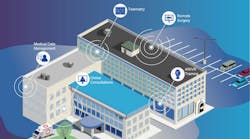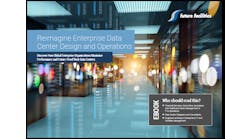In this week’s Voices of the Industry, Earl Keisling, co-founder and CEO of Inertech LLC, the data center infrastructure technology division of Aligned Energy, discusses why data center water use matters, and what can be done to make our use of this essential resource sustainable.
U.S. data centers consumed 626 billion liters of water in 2014 and are on track to consume 660 billion liters of water by 2020. That is according to the recent United States Data Center Energy Usage Report, which was based on research conducted by the Lawrence Berkeley National Laboratory, in collaboration with researchers from Stanford University, Northwestern University, and Carnegie Mellon University.
It is easy to see why data centers’ water consumption is huge, and rising: demand for the service the data center provides – that is, compute, network, and storage – is increasing exponentially. Having increased fivefold between 2010 and 2015, by the end of 2016 annual global Internet traffic (a reasonable proxy for compute load trends) will have exceeded one zettabyte, according to Cisco. Just four years later, it will have doubled. (Read more here.)
Data center water use affects the planet, yes, but also companies’ financials
Already, water scarcity affects 4 billion people, according to research by Mesfin M. Mekonnen and Arjen Y. Hoekstra of the University of Twente in the Netherlands. Water crises rank just behind climate change and weapons of mass destruction as the most impactful risk for the years to come, according to the World Economic Forum’s Global Risks Perception Survey.
In this kind of environment, rising data center water consumption is simply not sustainable.
Because of the impact data centers’ water consumption has on an already water-stressed planet, investors are now paying attention to companies’ “water footprints” just as they pay attention to their carbon footprints.
As Himani Phadke, research director at the Sustainability Accounting Standards Board, a non-profit that writes corporate sustainability reporting guidelines for investors, said in a recent Bloomberg article, “Operational efficiencies at data centers have a direct link to companies’ profitability and pose an increasing risk for investors in a ‘tense’ climate change environment.”
In the same article, William Sarni, director and practice leader of Water Strategy at Deloitte Consulting LLP explained that investor concern about corporate water use will only continue to grow. “Over the past few years, we have seen a dramatic increase of interest in water as a business risk and also as a business opportunity issue. I see it accelerating.”
What can be done to reduce data centers’ water impact
Exponentially rising demand for data center services leads to rising water consumption by data centers. Add to that worldwide water scarcity, and rising investor concern about companies’ data center water use, and the end result is a very clear and immediate need for data centers to use less water.
Data centers can do that, first and most obviously, by using less water. By far the largest opportunity for direct water savings in the data center is the cooling system. Perhaps less obviously though, there is an even greater opportunity for indirect water savings: using less power. Of the 626 billion liters of water consumed by data centers in 2014, about 80% of it was used in the generation of power for the data center.
I can remember very clearly being at a job site standing outside next to the enormous cooling towers and thinking, “There has to be a better way.” My co-founders and I worked hard to innovate that better way. We completely rethought the approach to data center cooling, and the result is a system that uses up to 85% less water and 80% less power than a traditional cooling system.
Instead of the traditional water- and power-guzzling chiller plant, a CACTUS® cooler is an air-cooled adiabatic rejection system comprised of two major components: a fluid cooler with an indirect evaporative cooling mode, and a compressor trim unit. The design combines both condenser heat rejection and water-side economization functions into the same product. In contrast to traditional chillers, this system relies on free cooling most of the time, even in hot climates. When temperatures can’t support 100% free cooling, the system makes use of indirect evaporative cooling and trim compression. The cycle consistently and effectively manages water and compression power consumption.
Thanks to cooling technology by Inertech (pictured here), Aligned Data Centers uses up to 85% less water and up to 80% less energy than a traditional data center.
Inside the data center, instead of a traditional forced-air system, we’ve close-coupled heat sinks above the racks to absorb the heat at its source, allowing hot air to rise and cooler, denser air to settle where it is needed. A heat sink draws the hot air from the servers, passes it across coils and “neutralizes” the heat without chilling it – sending 75-77°F air to the server inlets at the front of the enclosure. Removing heat at its source takes far less energy than making outside air cold and blowing it into the data center to mix with the hot air there, and it is more effective.
…and maintain reliability
Key in any measure to reduce water and power consumption in the data center is to do it without sacrificing reliability. Until recently, there haven’t been technologies available to allow data centers to be more efficient and maintain their reliability.
The bottom line
Water use is huge and growing. And it matters, to all of us. Two-thirds of the global population already face water scarcity, and it is only going to get worse. It affects companies’ financials, too, as investors are beginning to ask about companies’ “water footprints” as they ask about their carbon footprints. Fortunately, there are innovations that can dramatically reduce data centers’ water consumption, without sacrificing reliability.
Earl Keisling is a co-founder and CEO of Inertech LLC, the data center infrastructure technology division of Aligned Energy. He has been awarded multiple patents and is a master mechanical engineer with more than 30 years of experience designing and building large, complex construction and infrastructure projects. Inertech’s solutions has been proven to be even more reliable than a traditional forced-air/chiller plant cooling system. (Learn why here.)





